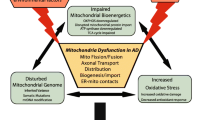Abstract
Growing evidence suggests that mitochondrial dysfunction is closely linked to the pathogenesis of sporadic Alzheimer’s disease (AD). One of the key contributors to various aspects of AD pathogenesis, along with metabolic dysfunction, is mitochondrial dynamics, involving balance between fusion and fission, which regulates mitochondrial number and morphology in response to changes in cellular energy demand. Recently, Zhang et al. ((2016) Sci. Rep., 6, 18725) described a previously unknown mitochondrial phenotype manifesting as elongated chain-linked mitochondria termed “mitochondria-on-a-string” (MOAS) in brain tissue from AD patients and mouse models of AD. The authors associated this phenotype with fission arrest, but implications of MOAS formation in AD pathogenesis remain to be understood. Here we analyze the presence and number of MOAS in the brain of OXYS rats simulating key signs of sporadic AD. Using electron microscopy, we found MOAS in OXYS prefrontal cortex neuropil in all stages of AD-like pathology, including mani-festation (5-month-old rats) and progression (12–18-month-old rats). The most pronounced elevation of MOAS content (8–fold) in OXYS rats compared to Wistar controls was found at the preclinical stage (20 days) on the background of decreased numbers of non-MOAS elongated mitochondria. From the age of 20 days through 18 months, the percentage of MOAS-containing neuronal processes increased from 1.7 to 8.3% in Wistar and from 13.9 to 16% in OXYS rats. Our results support the importance of the disruption of mitochondrial dynamics in AD pathogenesis and corroborate the existence of a causal link between impaired mitochondrial dynamics and formation of the distinctive phenotype of “mitochondria-on-a-sting”.
Similar content being viewed by others
Abbreviations
- Aβ:
-
amyloid beta
- AD:
-
Alzheimer’s disease
- MOAS:
-
mitochondria-on-a-string
- ROS:
-
reactive oxygen species
References
Morley, J. E., Armbrecht, H. J., Farr, S. A., and Kumar, V. B. (2012) The senescence accelerated mouse (SAMP8) as a model for oxidative stress and Alzheimer’s disease, Biochim. Biophys. Acta, 1822, 650–656.
Swerdlow, R. H., Burns, J. M., and Khan, S. M. (2014) The Alzheimer’s disease mitochondrial cascade hypothesis: progress and perspectives, Biochim. Biophys. Acta, 1842, 1219–1231.
Payne, B. A. I., and Chinnery, P. F. (2015) Mitochondrial dysfunction in aging: much progress but many unresolved questions, Biochim. Biophys. Acta, 1847, 1347–1353.
Ziegler, D. V., Wiley, C. D., and Velarde, M. C. (2015) Mitochondrial effectors of cellular senescence: beyond the free radical theory of aging, Aging Cell, 14, 1–7.
Westermann, B. (2012) Bioenergetic role of mitochondrial fusion and fission, Biochim. Biophys. Acta, 1817, 1833–1838.
Zhu, X., Perry, G., Smith, M. A., and Wang, X. (2013) Abnormal mitochondrial dynamics in the pathogenesis of Alzheimer’s disease, J. Alzheimers Dis., 33, 253–262.
Kim, D. I., Lee, K. H., Oh, J. Y., Kim, J. S., and Han, H. J. (2017) Relationship between β-amyloid and mitochondrial dynamics, Cell. Mol. Neurobiol., 37, 955–968.
Zhang, L., Trushin, S., Christensen, T. A., Bachmeier, B. V., Gateno, B., Schroeder, A., Yao, J., Itoh, K., Sesaki, H., Poon, W. W., Gylys, K. H., Patterson, E. R., Parisi, J. E., Diaz Brinton, R., Salisbury, J. L., and Trushina, E. (2016) Altered brain energetics induces mitochondrial fission arrest in Alzheimer’s disease, Sci. Rep., 6, 18725.
Morozov, Y. M., Datta, D., Paspalas, C. D., and Arnsten, A. F. T. (2017) Ultrastructural evidence for impaired mitochondrial fission in the aged rhesus monkey dorsolateral prefrontal cortex, Neurobiol. Aging, 51, 9–18.
Youle, R. J., and van der Bliek, A. M. (2012) Mitochondrial fission, fusion, and stress, Science, 337, 1062–1065.
Kolosova, N. G., Stefanova, N. A., Korbolina, E. E., Fursova, A. Zh., and Kozhevnikova, O. S. (2014) Senescence-accelerated OXYS rats-a genetic model of premature aging and age-related diseases, Adv. Gerontol., 4, 294–298.
Stefanova, N. A., Kozhevnikova, O. S., Vitovtov, A. O., Maksimova, K. Y., Logvinov, S. V., Rudnitskaya, E. A., Korbolina, E. E., Muraleva, N. A., and Kolosova, N. G. (2014) Senescence-accelerated OXYS rats: a model of age-related cognitive decline with relevance to abnormalities in Alzheimer’s disease, Cell Cycle, 13, 898–909.
Stefanova, N. A., Muraleva, N. A., Korbolina, E. E., Kiseleva, E., Maksimova, K. Y., and Kolosova, N. G. (2015) Amyloid accumulation is a late event in sporadic Alzheimer’s disease-like pathology in nontransgenic rats, Oncotarget, 6, 1396–1413.
Tyumentsev, M. A., Stefanova, N. A., Muraleva, N. A., Rumyantseva, Y. V., Kiseleva, E., Vavilin, V. A., and Kolosova, N. G. (2018). Mitochondrial dysfunction as a predictor and driver of Alzheimer’s disease-like pathology in OXYS rats, J. Alzheimers Dis., 63, 1075–1088.
Stefanova, N. A., Muraleva, N. A., Skulachev, V. P., and Kolosova, N. G. (2014) Alzheimer’s disease-like pathology in senescence-accelerated OXYS rats can be partially retarded with mitochondria-targeted antioxidant SkQ1, J. Alzheimers Dis., 38, 681–694.
Stefanova, N. A., Maksimova, K. Y., Kiseleva, E., Rudnitskaya, E. A., Muraleva, N. A., and Kolosova, N. G. (2015) Melatonin attenuates impairments of structural hippocampal neuroplasticity in OXYS rats during active progression of Alzheimer’s disease-like pathology, J. Pineal Res., 59, 163–177.
Cai, Q., and Tammineni, P. (2017) Mitochondrial aspects of synaptic dysfunction in Alzheimer’s disease, J. Alzheimers Dis., 57, 1087–1103.
Correia, S. C., Perry, G., and Moreira, P. I. (2016) Mitochondrial traffic jams in Alzheimer’s disease-pin-pointing the roadblocks, Biochim. Biophys. Acta, 1862, 1909–1917.
Author information
Authors and Affiliations
Corresponding author
Additional information
Original Russian Text © M. A. Tyumentsev, N. A. Stefanova, E. V. Kiseleva, N. G. Kolosova, 2018, published in Biokhimiya, 2018, Vol. 83, No. 9, pp. 1361–1367.
Rights and permissions
About this article
Cite this article
Tyumentsev, M.A., Stefanova, N.A., Kiseleva, E.V. et al. Mitochondria with Morphology Characteristic for Alzheimer’s Disease Patients Are Found in the Brain of OXYS Rats. Biochemistry Moscow 83, 1083–1088 (2018). https://doi.org/10.1134/S0006297918090109
Received:
Revised:
Published:
Issue Date:
DOI: https://doi.org/10.1134/S0006297918090109




